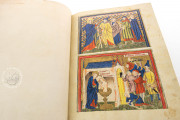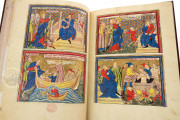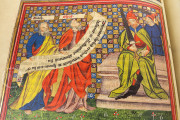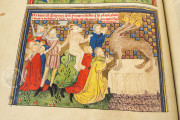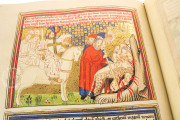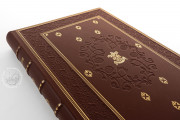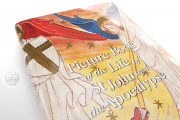This illustrated Life of John and the Apocalypse was created in northwestern Germany or the Netherlands around the turn of the fifteenth century. The manuscript includes nearly one hundred separate scenes. They tell the story of the Life of Saint John the Divine, the author of the biblical book of the Apocalypse, known in the Protestant tradition as Revelation, and illustrate the events described in the Apocalypse. They are framed with gold and alternating blue and red, and every miniature is enhanced with gold.
The manuscript's heavily abbreviated Latin text is enhanced with rubrication and opens with a splendid puzzle initial. Additional text appears within the images themselves as banderoles from heaven or labels for events and characters. The biblical text is rather secondary to the illustrations, suggesting that the images were of primary importance for the patron. The book stands as a beautiful representation of the late medieval Apocalypse manuscript tradition in northern Europe.
Golden Splendor on Every Page
All of the miniatures in this Apocalypse include gold, used to render objects, such as crowns and stars, and to create entire shimmering backgrounds. The rich colors of mostly red, blue, and green are spectacularly vibrant. The artist was not of superior talent, but there is a charm to the rendering of the figures, which lends a human touch to the grim subject matter. Overall, this sumptuous manuscript is an impressive deluxe copy of a popular biblical text.
Three Texts in One
This copy of the Apocalypse includes Saint Jerome's preface, as well as an almost entirely visual version of the Life of Saint John. The pictorial biography (fols. 1-2 and 45-47) serves as a narrative container for the visions of the End Times. The Latin text of the manuscript, written in Gothic Textualis, is laid out in thirty-eight long lines generally on the recto of a leaf with the verso containing two half-page scenes one above the other.
A Copy and an Exemplar
This Apocalypse is a copy of an English Apocalypse (also the examplar for Manchester, John Rylands Library, MS Lat. 19 and London, Welcome Institute, MS 49) and provided the basis for at least one early printed version. Because of its position as both a copy and an exemplar, it is a key manuscript for appreciating the exchange of art and ideas in the Middle Ages. The book was owned by the collector Alfred Henry Huth, as indicated by his bookplate, and was bequeathed by him to the British Museum in 1910. The binding is of plain brown leather with gold-tooled foliate decoration on the spine.
We have 1 facsimile edition of the manuscript "Life of John and the Apocalypse": Apocalipsis y Vida de san Juan en miniaturas facsimile edition, published by M. Moleiro Editor, 2016
Request Info / Price






